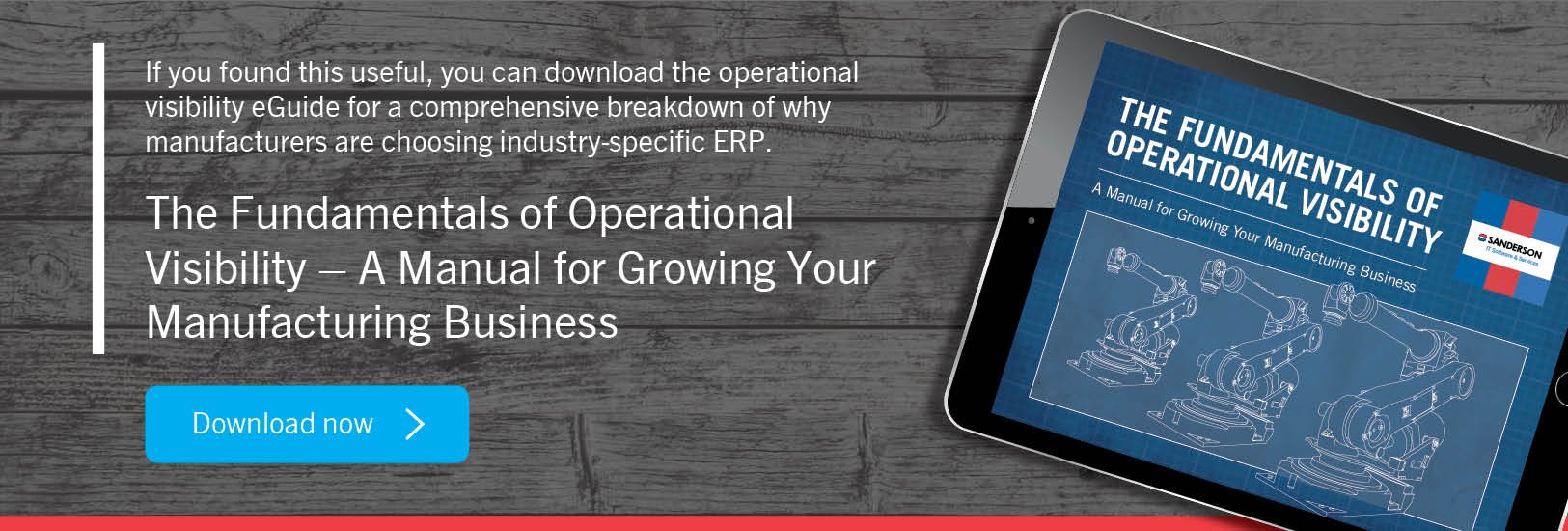Would you like to achieve operational visibility in your manufacturing business? Use this ERP checklist to start your journey.

As manufacturers face increasingly keen competition and rising customer expectations, a dedicated ERP solution is an effective way of taking control of your business and ensuring you always have accurate, up-to-date information on every aspect of your operations. The right system can improve decision-making, break down silos across your company, and eliminate errors; helping you to boost productivity, cut waste, and maximise profits.
Whether you’re introducing ERP to your operations for the first time or replacing older software, you’ll need to assess the specific circumstances of your business before taking a purchasing decision. That means working out exactly what your company needs from the system, establishing how it can improve visibility, and finding the right partner so that the ERP is properly implemented, supported, and your team can start reaping the benefits from day one.
This checklist is a guide of the areas you’ll want to think through thoroughly.
 |
1. Is your business hampered by older processes? |
Are some of your company’s operations becoming bogged down because of paperwork, manual inputs and spreadsheets? It’s likely that some of these functions can be automated in order to save staff time, improve accuracy and speed up decision-making.
Action: Review the manual processes taking place across your business, paying close attention to whether they can be automated and whether they allow inefficiencies to creep into your operations.
 |
2. Can your company improve its handling of data and visibility? |
One of the chief problems that businesses face is the tendency of departments to start operating in ‘silos’, with insufficient emphasis on communicating clearly toward a common goal. This issue is exacerbated when it’s difficult to compile and access information from various parts of the organisation. The key value of operational visibility is the ability to make use of up to date data and draw valuable insights from its analysis. That means it has to be accessible quickly and in a format that is useful and digestible.
Action: Analyse how your business currently collates and shares its information, with a view to producing useful data analytics that can help improve operations.
 |
3. Are you making decisions based on assumptions rather than actualities? |
When it comes to analysing business performance and planning ahead, you’ll want to think about whether your company is basing its decisions on assumptions or verifiable information. If you’re habitually having to take a guess at exactly what’s going on in your organisation, then errors are likely to creep into reporting and analysis. An effective ERP system, including an appropriate level of automation, will help ensure that you’ve got an accurate picture of your operations and that the insights you derive from your data are robust.
Action: Audit your reporting and analysis processes, with a view to identifying where assumptions can be replaced with concrete information.
 |
4. Is lack of visibility creating the potential for inefficiencies and delays? |
In a competitive manufacturing environment, you’ll be accustomed to constantly reviewing the performance of your business; problems can arise if this evaluation is based on out-of-date or incomplete intelligence about your organisation. Have your processes being affected by inefficiencies and delays that could be eliminated if problems were flagged up more quickly?
Action: Examine closely where inefficiencies and delays have arisen in your organisation, in order to determine whether difficulties could have been identified earlier if the correct information had been more quickly available.
 |
5. Can you establish a single source of truth for your business? |
It might sound rather grandiose, but having a ‘single source of truth’ simply means that the information your business generates is collated accurately, rapidly, and in a format you can easily use and understand. This goal is undermined if your system is dependent upon different software packages, manual data inputs, or retrieving reports from filing cabinets.
Action: Assess whether the different departments in your company could be working in a more joined-up fashion and whether the data they collect is feeding into a single, dedicated source.

Toward a solution
Once you’ve examined these aspects of your business, you’ll have a clearer picture of how operational visibility can be improved and what you want to get out of an ERP solution. In each of these areas spreadsheets, paperwork, and manual inputs can obscure your view of what is happening in your organisation, while a dedicated solution provides a clearer more accurate picture.
In a challenging business environment you want an edge on your competitors, and the right ERP software, delivered by the right partner, gives your company the tools to be at the very top of its game.
Topics: Operational visibility, ERP




